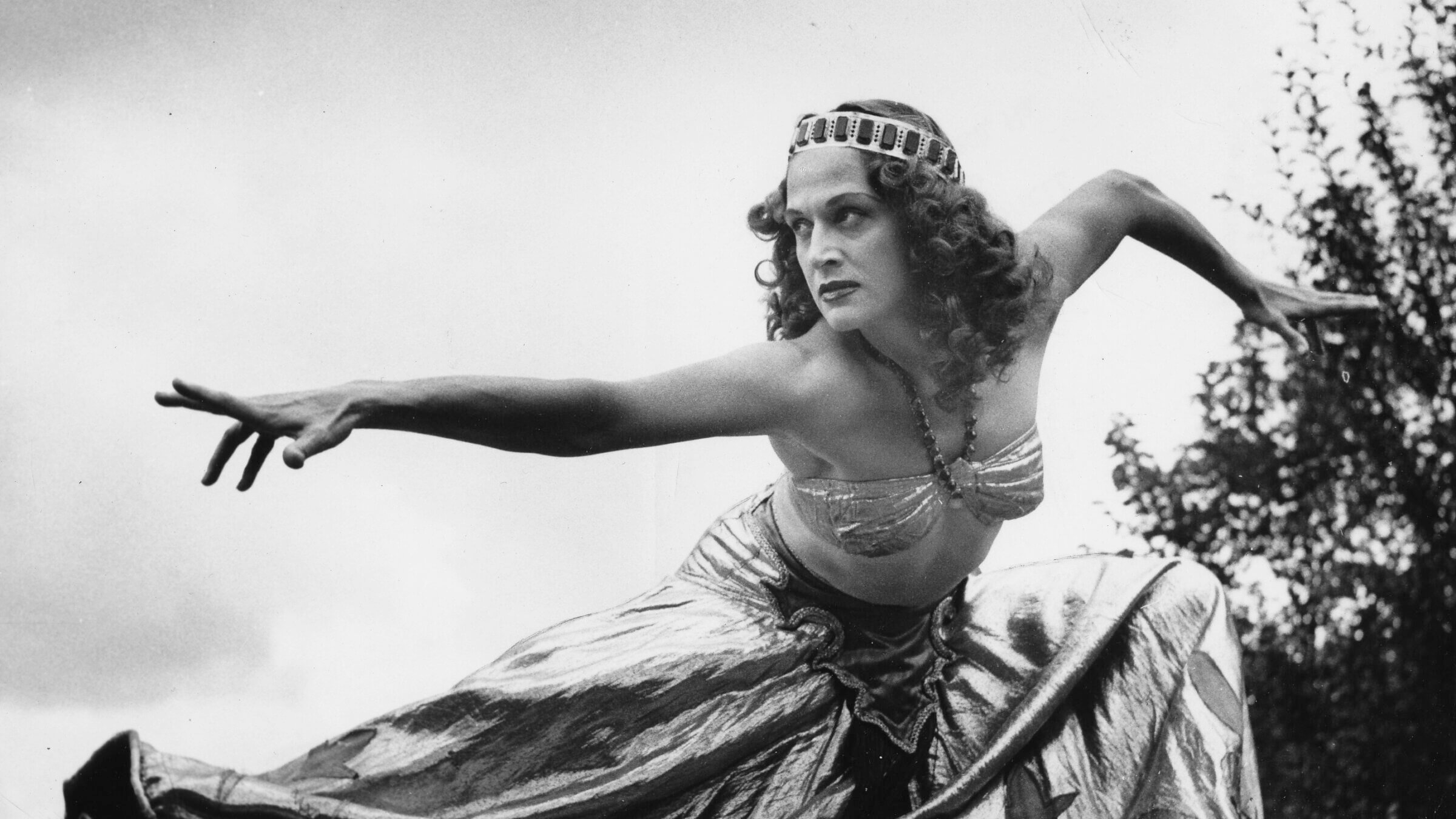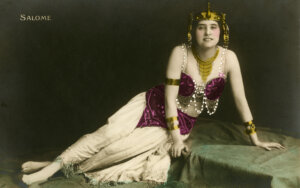How a scandalous Jewish no-goodnik captured the imagination of the world
For more than a century, audiences have thrilled to the temptations of Salome and ‘Salomania’

Ballerina Mia Slavenska performs as Salome at Jacob’s Pillow, summer 1950. Photo by Getty Images
Jewish performers and spectators have long been bewitched by Salome, an otherwise obscure minor character name-checked by the historian Josephus in Antiquities of the Jews.
As a new study by Cecily Devereux from WLU Press implies, the so-called Salomania dance craze gripped turn-of-the-century artists and theatergoers alike, with Yiddishkeit as an inextricable part of the allure.
In the Gospels of Mark and Matthew, an unnamed stepdaughter of Herod Antipas, ruler of Galilee, danced before him at his birthday celebration, after which she was told she could ask for anything in return. After consulting with her mother, Salome is said to have requested the head of John the Baptist.
This unsavory tale was essentially a Christian construct, and so, unsurprisingly, the Jewish Salome was rarely seen as an admirable character. Her villainy was amped up in 1891 by a one-act tragedy on the theme by Oscar Wilde, originally written in French. It was seen as an excuse for naughty doings with a biblio-historical veneer as well as an occasion for a hifalutin striptease in Salome’s Dance of the Seven Veils, a Wildean invention immortalized in Richard Strauss’s 1905 opera Salome.
So avid were Jewish audiences to see Wilde’s Salome at a time when the author’s plays were still banned from London stages after his imprisonment for “gross indecency” that Salome was translated into Yiddish and performed onstage in New York by 1908.
Some researchers have claimed that a century ago, Yiddish theater audiences kvelled at Salome as a soul sister of the Jewish widow Judith, who did her own beheading of a tyrant, the Assyrian general Holofernes in the Book of Judith. Yet Judith was scarcely comparable to Salome, who merely echoed her mother’s wish to have John the Baptist beheaded.
The historian Sander Gilman has opined that the American and European public mostly thrilled to Salome as an exemplar of the danger of Jews as a degenerate race damaging to Christians. Yet this theory would not explain the enthusiasm of Yiddish theater audiences for the story.
Some genuinely admirable women named Salome have won distinction in Jewish history, among them Salome Alexandra, last regnant queen of Judea, remembered as an accomplished administrator and military strategist. A different, no less distinguished, Salome appears in the apocryphal Gospel of James as an associate of the unnamed midwife at the birth of Jesus.

But neither of these stalwarts has won the lasting fame and popularity of the teenage no-goodnik who inspired the arts world with her misdeeds. Devereux notes a 1908 London house party attended by King Edward VII, a philosemite who famously told his cousin Czar Nicholas II that Russian Jews should be treated better.
At the party, an English aristocrat imitated the Canadian dancer Maud Allan, who had recently scandalized the Brits in a performance as Salome, which led some to posit that Allan was so objectionable, she must herself be Jewish.
The performer concluded her party tribute act by resting her head on the King’s knee and declaring, “Sire, I claim the head of Sir Ernest Cassel,” referring to a German Jewish royal friend and business associate. This attempt at a witty replacement of John the Baptist with a Jewish ally of the king was considered rude, and before long, the noblewoman was no longer welcome at Court.
Another Salome dancer to whom Yiddishkeit was wrongly attributed was Mata Hari, a Dutch exotic dancer and courtesan who was convicted of being a spy for Germany during World War I and executed by firing squad in France. Although biographers later concluded she had no Jewish ancestry, and indeed might have been innocent of the charges against her, Mata Hari’s supposed roots were seen by contemporaries as cohering with the evil deeds of the character she portrayed.
Some Jewish Salomes found unsuspected virtues in the character, a the diva’s prerogative of incarnating a youthful role well into middle age. Among these were Sarah Bernhardt, dancer Ida Rubinstein, and Theda Bara (born Goodman), daughter of a Polish Jewish tailor who starred in a 1918 screen version of which only fragments survive.
Also lost was a 1923 film adaptation of Salome of the Tenements by Anzia Yezierska, a novelist noted for capturing the Jewish immigrant experience. As the Americanist Alan Robert Ginsberg observed, other Jewish talents involved in adapting Yezierska’s tale for Hollywood included Russian-born screenwriter Sonya Levien and Dutch actress Jetta Goudal. The novelist’s real-life inspiration for the eponymous heroine, a mishmash of Salome and Cinderella, was reportedly the Jewish social activist Rose Pastor Stokes (born Wieslander).
Unlike these exalted statements, Salome was also a target of Jewish derision in a 1908 tune by Irving Berlin, premiered by the original Funny Girl, Fanny Brice. Sung in a Yiddish accent, “Sadie Salomé, Go Home” featured a lovesick swain named Mose complaining about his paramour flaunting herself in public: “Don’t do that dance, Sadie/ Dat’s not business for a lady/ Most everybody knows that I’m your loving Mose,/ Oy, oy, oy where is your clothes,/ Sadie Salomé please go home.”
Brice included a spoof version of the Dance of the Seven Veils, garbed in a sailor suit, to complement the melody. Yet contemporaneously, Ida Rubinstein, described by the fashionista Diana Vreeland as a “sexy Jewish girl with quite a lot of money” and by Jean Cocteau as a “great ibex of the Jewish ghetto,” sponsored her own ultra-serious Salomé productions.
As recounted in Rebecca Rossen’s Dancing Jewish, Rubinstein routinely received antisemitic responses from the media and local clergy for these shows, presented in 1908 in Russia and 1912 in France.
Professional rivals like impresario Serge Diaghilev were no less excoriating. Diaghilev wrote to future Nazi collaborator Serge Lifar to mock Rubinstein’s company as “Les Ballets Juifs” (The Jewish Ballet).
Undaunted, Rubinstein went on to incarnate Saint Sebastian, a Christian martyr, in a 1911 mystery play with music by Claude Debussy, giving shpilkes to her French Jewish producer Gabriel Astruc. After having weathered condemnations from the French Catholic church for presenting Rubinstein’s Salome, Astruc feared that her new Saint Sebastian would only prove “that for the second time I have crucified God!”
No less targeted for obloquy was the Russian Jewish actress Alla Nazimova (born Marem-Ides Leventon) whose own filmed version of Salome (1922) fortunately survives as a kind of fever dream induced by eating too many kreplach.
Produced and directed by, as well as starring, a goggle-eyed 40-ish Nazimova as the teen Salome, the film suggests an Ed Wood aesthetic, redeemed by the Jewish star’s stalagmite-like presence.
Ultimately, Salome, described by composer Richard Strauss as “my crazy Jewish girl,” was diversely enticing, as writer and dancer Toni Bentley argued. Appealing to different spectators for different reasons, she continues to inspire Jewish creative spirits, most recently the Canadian poet Adeena Karasick, author of a feminist take on the subject, Salomé: Woman of Valor, (2014) whose protagonist has been likened to a warrior princess.
Whether ideal or shande, the Jewish Edomite princess of yore still captivates Jews onstage and in audiences.






















